Bookmarked from all around the web. For my personal use.
Don't wanna be here? Send us removal request.
Text
Steak Tacos with Cabbage and Salsa
Recipe & photo: Proportional Plate, via foodffs
Marinade overnight if you can, 2 hours minimum. I like to take the leftover marinade, bring it to a boil, and simmer it for 45 minutes. It reduces down into a delicious sauce.

Steak Marinade
2 lb. flank steak
1 orange juiced
2 limes juiced
1/4 cup olive oil
1/4 cup agave
5-6 cloves garlic minced
1 tbsp dried oregano
1 tbsp chili powder
1/4 tsp kosher salt
2 avocados sliced (or smashed if fancy looks don't matter to you)
Pico de Gallo Salsa
1 large tomato diced
1/2 red onion diced
1 jalapeño finely diced, seeds removed for a milder salsa
1 lime juiced
1 tbsp olive oil
salt and pepper to taste
Tacos
flour or corn tortillas heated just before serving
1/4 purple cabbage shredded or very thinly sliced
limes cut in wedges, for serving
Method
Turn on the broiler on high. Let heat for 1 minute after the flame comes on.
Put the flank steak in the oven. Cook 5 minutes.
Remove steak from the oven. Leave the oven on and the oven door open. Flip the steak.
Cook until internal temperature reads ~135 for medium-rare. (4-5 more minutes).
Let rest 5-10 minutes before slicing against the grain and serving.
Salsa: Mix ingredients in a bowl. Set aside. Can be made a day in advance.
Marinade the steak in the refrigerator overnight in the orange juice, lime juice, olive oil, agave, minced garlic, oregano, chili powder, and salt. Take it out of the refrigerator 20-30 minutes before you cook it.
Pour the juices from the marinade in a sauce pan. Bring to boil, lower to a simmer, and reduce the marinade by half. Takes 10-15 minutes. You can cook your steak in the meantime.
Assemble your tacos with the cabbage on the bottom, then the steak, and top with the salsa. A squeeze of lime makes it just right. Drizzle the reduced sauce on top.
I’ve cooked the steak in these tacos on the grill, under the broiler, and even on the stovetop. My two favorites are under the broiler and on the grill, but you really just can’t go wrong with these flavors. Inspired by Giada de Laurentis’s fajitas.
0 notes
Text
Raspberry Pancakes
Nigel Slater | The Guardian

In deepest summer I like to make a rose-scented sugar for pancakes, scattering the pale pink sugar over them with a squeeze of lemon. Equally delicious is a homemade raspberry preserve, served warm from the stove. A little cream is good here, too.
Serves 3-4
For the pancakes butter 30g plain flour 100g caster sugar a level tbsp egg 1 large, plus an extra egg yolk milk 350ml
For the raspberry preserve raspberries 500g granulated sugar 400g lemon 1
Make the pancakes. Melt the butter in a small pan, remove from the heat and leave to cool. Sift the flour together with a pinch of salt into a large bowl. Stir in the sugar.
Make a well in the centre then pour in the egg and egg yolk, lightly beaten, and the milk. Bring the flour slowly in to the middle, beating lightly to get a smooth batter. Set aside for half an hour.
Put the raspberries in a deep saucepan and add the sugar. Finely grate the zest from the lemon, squeeze its juice and add both to the pan. Bring to the boil and continue boiling for five minutes. Remove from the heat, removing any froth from the surface, then set aside.
Brush a 20-22cm non-stick frying pan or crepe pan with a little melted butter. When the butter starts to sizzle, give the batter a quick stir, then pour or ladle in enough to give a wafer-thin layer. Tip the pan around so the batter covers the bottom. Let it cook for a minute, then run a palette knife around the edge to loosen it. Slide the palette knife underneath, then flip the pancake over quickly and smoothly. Leave to cook for a minute or two then slide out on to a plate.
Continue with the rest of the mixture. You should make about 6-8 pancakes. Serve the pancakes with thick cream and the raspberry preserve.
You can make a scented sugar to scatter over the pancakes if you prefer. Process a large red garden rose (not one from a shop) with 3 tablespoons of sugar in a food processor. When the sugar is pink, scatter over the pancakes with a squeeze of lemon.
Photograph: Jonathan Lovekin for the Observer
2 notes
·
View notes
Text
Peach and Honey Cake
Nigel Slater | The Guardian

A cake, studded with fresh fruit, works as both dessert and teatime treat. If this cake, with its layer of soft peaches and crunchy pine nuts, is to come out at the end of a meal, I would include a jug of pouring cream, too.
Serves 8-10
peaches 3 ripe honey 4 tbsp rosemary 1 sprig
For the batter ground almonds 80g plain flour 100g baking powder ¾ tsp butter 180g caster sugar 180g eggs 3 large lemon 1 pine nuts 2 tbsp
Line the base of a 20cm round, deep, springform cake tin. Set the oven at 180C/gas mark 4.
Halve the peaches, remove their stones and slice each half into four. Place the slices on a foil-lined grill pan, trickle over 2 tablespoons of the honey then leave under a hot grill till their edges have started to caramelise. Watch them carefully throughout the process. Finely chop the rosemary needles.
Mix together the ground almonds, plain flour and baking powder. Cut the butter into small dice then beat to a pale, thick cream with the sugar using a food mixer. Break the eggs into a bowl and beat them lightly. With the beater turning at low speed, alternately add the egg and flour mixtures until you have a smooth, thick cream. Finely grate the zest of the lemon and stir in. Spoon into the lined cake tin.
Place the grilled peaches on top of the cake – they look best randomly distributed rather than neatly arranged – then scatter over the pine nuts and the chopped rosemary needles. Bake for 45 minutes, until lightly firm and golden, then remove and brush with the remaining honey. Leave to cool before turning out of the tin.
Photograph: Jonathan Lovekin for the Observer
2 notes
·
View notes
Text
Apricot and Rosemary Focaccia
Nigel Slater | The Guardian
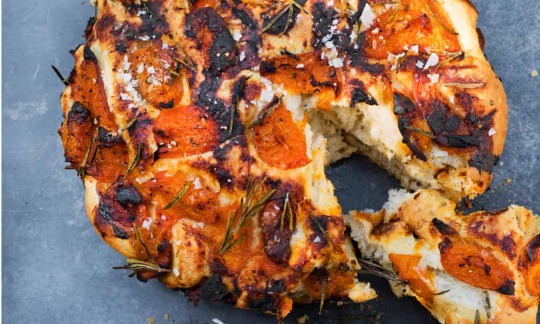
I have long been an advocate of the baking stone – a thick piece of stone or chunky unglazed tile left in the bottom of the oven to heat up, on which to cook bread or pastry. The extra heat held by the stone ensures a crisp base to pies, loaves, tarts and focaccia. My own has done years of service both as direct heat for a pizza or loaf and as something on which to sit a baking sheet or tart tin. If you are thinking of picking one up for your oven, may I suggest the heavier the better? Whatever, they do wonders for a focaccia.
Serves 8
strong white bread flour 500g easy-bake yeast 1 7g sachet sea salt 1 tsp olive oil 2-3 tbsp warm water 350ml apricots 400g olive oil 4 tbsp rosemary 3 bushy sprigs
Rub the bottom of a baking tin, approximately 22cm in diameter, with a little of the olive oil. Set the oven at 230C/gas mark 7.
Put the flour and yeast into a large mixing bowl and crumble in the sea salt, then the olive oil and the warm water. Mix thoroughly, adding more water if necessary, to produce a soft, but not sticky dough.
Generously flour a board or work surface, tip out the dough, then knead or fold gently but firmly for about 5 minutes. If you wish, use a food mixer with dough hook.
When the dough feels elastic, transfer to a lightly floured bowl, cover with a cloth or clingfilm and leave in a warm place to rise for about an hour, until it has doubled in size.
Cut the apricots in half and remove their stones. Warm the olive oil in a shallow pan, add the apricots and let them cook for a few minutes until they have softened. Pull the rosemary needles from their stems and add to the apricots, then set aside.
Gently remove the dough from its bowl and push it into the oiled tin, pressing it out to reach the edge.
Place the apricots on top of the dough then spoon over the rosemary and oil from the tin. Cover with a cloth and leave to rest in a warm place until the dough has risen almost to the top of the tin. Scatter lightly with sea salt.
Bake for about 30-35 minutes until the fruit is starting to brown here and there and the dough is springy to the touch. Remove from the oven and leave to cool for 15 minutes before removing from the tin. Place on the table, with some goat’s cheese, for everyone to tear apart.
Photograph: Jonathan Lovekin for the Observer
0 notes
Text
Apricot Tarte Tatin
Nigel Slater | The Guardian
I enjoy the rhythm of cooking – the delicious ritual of getting something to eat on the table every day. But if I am honest, there are some kinds of cooking I enjoy more than others: such as last weekend, when I spent a couple of hours in the kitchen for no reason other than the pleasure of baking.
The quiet joy of cooking for cooking’s sake: for the hypnotic pleasure of kneading dough; the benign smell of a cake baking in the oven; for the reign of calm that presides over a kitchen where a cook is quietly at work. And, yes, for something good that can be shared at the end.
I didn’t have to make a fruit tart. Especially one that smelt of warm pastry, sweet caramel and ripe apricots. Neither was it essential that I put together another one, altogether simpler, with a tender crust that crumbled as hoped, with a thick, piquant cream and a veritable mound of soft, summer fruits. But I did. It is a sad kitchen that can’t be used purely for fun sometimes.
Anyone interested in the marriage of soft fruits and crisp crusts will look forward to this time of year like no other. From blueberries and cherries to the first plums, from glistening whitecurrants to deep, crimson-black logans, this is the peak of the tart-maker’s year. Peaches on a frangipani base; damsons under a pebbly, oat and almond crust; plums sliced and layered on a sheet of fine, crisp puff pastry. Each and every one is a gift to the eater, but also a gift to the cook.
I am not sure it matters whether your tart is a flawless masterpiece or something more friendly and wobbly at the edges. What matters is the offering of something you made simply for the pleasure involved – something made with a light heart. Good food from a good place.

Ripe fruit, pastry, caramel. The making of the caramel can be tricky. I avoid the temptation to stir the butter and sugar too much, which can often make it become grainy. Just an occasional stir over a moderately high heat is best for a smooth caramel.
Serves 4
ripe apricots 500g (about 10) puff pastry 500g butter 50g caster sugar 50g
Set the oven at 200C/gas mark 6. Melt the butter in the tatin tin, then add the sugar and leave to bubble to a deep-brown caramel. Take care that the sugar doesn’t burn, and avoid the temptation to stir it too much.
Slice the apricots in half, remove the stones, then place the fruit cut-side up in the caramel. Continue cooking briefly, so that the fruit softens fully, then remove from the heat and allow to cool sightly.
Roll the pastry, then cut out a disc slightly larger than the tatin tin. Place the pastry over the top of the fruit. Tuck the overhanging edges of the pastry under the apricots around the edge. Bake for about 35-40 minutes, until the pastry is puffed and golden.
Let the tart settle and cool a little before carefully turning it out, taking great care with the hot caramel.
Photo: Jonathan Lovekin
0 notes
Text
Cherry Polenta Cake
Nigel Slater | The Guardian

Serves 8-10
butter 220g caster sugar 220g cherries 200g ground almonds 180g fine polenta 220g baking powder 1 tsp lemon 1 eggs 3, large For the syrup cherries 400g honey 3 tbsp elderflower cordial 160ml
Set the oven at 180C/gas mark 4. Line the base of a 20cm cake tin with baking parchment.
Dice the butter and put it in the bowl of a food mixer with the caster sugar and beat until light and creamy. Halve and stone the 200g of cherries.
Mix together the ground almonds, fine polenta and the baking powder. Grate the zest from the lemon and stir into the polenta. Squeeze the juice from the lemon into a small bowl. Break the eggs into a bowl and beat them lightly.
Add the beaten egg to the butter and sugar mixture, beating continuously, adding a little of the polenta mixture should it start to curdle. Fold in the remaining polenta mixture and the lemon juice.
Spoon half the batter into the lined cake tin, add the cherries, then the remaining batter and smooth the surface. Bake for 35 minutes, then lower the heat to 160C/gas mark 4 and bake for further 25 minutes until the cake is lightly firm to the touch.
While the cake bakes, make the syrup. Halve and stone the 400g of cherries. Warm the elderflower cordial and honey in a small pan, then add the cherries and let them simmer for 5-7 minutes until the fruit has given up some of its juice.
When the cake is ready, remove from the oven, then pierce all over with a skewer or knitting needle. Spoon some of the syrup from the cherries over the surface so it runs down through the holes into the crumb of the cake, then leave to cool.
Remove the cake from its tin; serve with the cherry compote and, if you like some cream or crème fraîche.
Photograph: Jonathan Lovekin for the Observer
0 notes
Text
Gnudi with Broccoli and Goat’s Curd
Nigel Slater | The Guardian
It cannot have escaped anyone’s attention that food is often more delicious for spending a night in the fridge – the most rewarding contenders being cassoulet-style bean recipes, meat-based stews, layered dishes such as lasagnes and meat (not seafood) curries. I would also add to that list pork spare ribs, but only because of the way the bones become tantalisingly charred and chewy on being reheated.
But while some dishes become more interesting, others need a while in the fridge if they are to work at all. Marinades of course, and “cold-cooked” recipes like ceviche, but I am really thinking of gnudi: the light, not-quite-spherical dumplings of ricotta and parmesan. On a good day they are so light as to be barely held together. They need at least 24 hours’ chilling on a bed of fine semolina in order to form a gossamer-thin skin to hold them in one piece. Failure to curb your impatience will result in your precious balls dissolving in the water. And no one wants that.
This week I also made a pot of lamb mince with coarsely grated butternut. Originally for a stuffing, it emerged from a night in the cold delicious enough to stand alone, piled in sizzling mounds on thick sourdough toast, its now mellowed, garlicky juices soaking down into the warm bread.

My gnudi is based on that of the wonderful April Bloomfield, whose own version has become a permanent, much-loved part of her menu at the Spotted Pig in New York. Mine have a little more parmesan to ricotta than is the norm, and my impatience means they get only 24 hours in the fridge. If the goat’s curd for the sauce evades you, crème fraîche will work, too.
Serves 4, makes 20 small gnudi
ricotta 250g nutmeg a little parmesan 40g fine semolina 250g or more
To finish thin-stemmed or purple sprouting broccoli 250g parmesan 100g butter 30g goat’s curd 150g
Put the ricotta into a bowl. Grate a little nutmeg finely over the cheese, then add a very little salt. Grate the parmesan finely and gently stir in. Have a baking sheet ready, covered with a thick layer of the semolina.
Using a teaspoon, scoop up a generous heap of mixture and make it into a small ball, rolling it in your hands. (A dusting of semolina on your hands will help.) You can leave the gnudi round if you like, but I prefer to press it into a slightly oval shape. Drop the ball on to the semolina-lined tray then roll it back and forth until it is coated. Continue with the rest of the mixture. You will have roughly 20 little gnudi. Once they are all rolled, shake the remaining semolina over them then put the tray in the fridge. Don’t be tempted to cover them. Leave overnight.
The next day, just before you are due to cook your gnudi, break the broccoli or sprouting into small florets, then cook in boiling water for 2-3 minutes, till just tender. Drain and plunge into iced water and set aside. Grate the parmesan finely.
Bring a pan of water to the boil, deep and generously salted, as you would to cook pasta. Carefully lower the gnudi, a few at a time, into the boiling water. When the balls float to the surface they are ready. This is generally between 3 and 5 minutes. Scoop out with a draining spoon and place in a warm serving dish.
Melt the butter in a shallow pan over a moderate heat, add the goat’s curd, then the drained cooked greens, and heat for a minute or two. Scatter in most of the parmesan. Spoon the broccoli and sauce over the gnudi and serve with more parmesan.
Photograph: Jonathan Lovekin for the Observer
0 notes
Text
Fettuccine with Dill and Bacon
Nigel Slater | The Guardian

The recipe
Into a blender or food processor, put 25g of fresh dill and 125g of grated parmesan. Blitz to coarse crumbs, then tip into a saucepan. Pour in 250g of double cream and bring gently to the boil, stirring until the parmesan has melted. Just as the cream starts to boil, remove from the heat, cover with a lid and leave for 10 minutes for the dill and cheese to flavour the cream.
Dice 180g of streaky bacon then cook until crisp in a nonstick pan. As the bacon is approaching crispness add two large finely sliced cloves of garlic. Continue cooking until the garlic is nicely toasted.
In a pan of deep water, cook 250g of fettuccine until tender, then drain. Bring the cream almost to the boil, then toss with the bacon and the dill and parmesan cream. I like to reserve a few bits of crisp bacon for the top. Serves 2.
The trick
Leaving the herbs and cheese to infuse in the cream works brilliantly. It is worth using for any impromptu pasta sauce. I do it with thyme, garlic, goat’s cheese and cream. It will also work if you want to infuse the cream with prawn shells and basil for a seafood pasta sauce. That’s a great combination, too.
The twist
You could use most of the ribbon or shell pasta shapes for this. If you wish to leave out the bacon, you might like to try chestnut mushrooms, thinly sliced and fried until deep golden brown instead.
Photograph: Jonathan Lovekin for the Observer
0 notes
Text
Cheesecake with Sesame and Mango
Nigel Slater | The Guardian

Serves 8-10
For the sponge caster sugar 125g butter 125g eggs 2 large self-raising flour 125g sesame seeds 25g
For the filling gelatine 2 leaves (4g) double cream 350ml caster sugar 150g lemon 1 cream cheese 650g vanilla extract 1 tsp
To finish ripe mangoes 850g lemon juice a little crushed sesame brittle 3 tbsp
Set the oven at 170C/gas mark 3. Line the base of a deep 20cm cake tin with baking parchment.
Beat the sugar and butter to a soft, light cream. Break the eggs into a bowl, beating them lightly with a fork to combine yolks and whites then introduce them slowly to the butter and sugar mixture, beating continuously. If the mixture curdles, then stir in a little of the flour.
Add the flour and half the sesame seeds then transfer to the lined baking tin. Scatter the remaining seeds over the top. Bake for about 25 minutes till springy to the touch. Remove from the oven and leave to settle for a few minutes before running a palette knife around the edge to free the cake from its tin, then leaving it on a cooling rack till cold.
Make the cheesecake filling: place the gelatine in a bowl of cold water and set aside. Pour the double cream into the bowl of a food mixer fitted with a balloon whisk, add the sugar then beat slowly till thick and creamy. Finely grate the lemon zest and squeeze the lemon juice. Warm 100ml of the juice in a small pan, remove the softened gelatine then stir into the juice until dissolved.
Fold the cream cheese, vanilla extract and the lemon zest into the cream mixture with a large spoon, then fold in the lemon and gelatine.
Slice the cooled cake in half horizontally, then place the bottom half back in the cake tin. Transfer the filling to the tin, spooning it on top of the layer of cake and smoothing the surface. Place the second half of the cake on top, cover with clingfilm, then place a weight on the cake. Leave the cake in the fridge for 2 hours to set.
Peel the mangoes and remove the flesh from their stones in thick slices, then chop or cut into thick matchsticks. Toss the mangoes in lemon juice and spread on top of the cake, scatter over the crushed brittle or serve at its side. Remove the cake from the tin and slice.
Sesame brittle
sesame seeds 50g caster sugar 80g
Have ready a nonstick baking sheet. Warm a shallow pan over a moderate heat, sprinkle the sesame seeds over the surface of the pan in a single layer. Watch carefully, shaking the pan from time to time, until the seeds are pale gold. Scatter the sugar over the seeds and leave to melt. As the sugar melts and turns gold, tip the pan left and right so the sugar melts evenly. Very gently, stir any bits that are browning into the middle of the pan. As soon as the sugar is honey-coloured, tip on to the baking sheet smoothing into a thin pool, then leave to set. Remove from the sheet by prising a palette knife underneath.
Photograph: Jonathan Lovekin for the Observer
0 notes
Text
Marinated Burrata, Blood Orange Salad
Nigel Slater | The Guardian
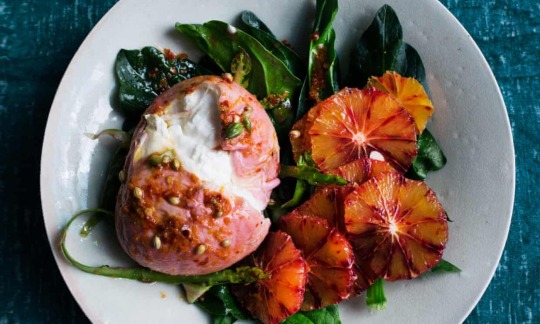
Buffalo mozzarella is fine here, too, but use burrata if you can get hold of it, for its texture – which is softer and more fragile.
Serves 2
burrata 150g, or mozzarella blood orange 1 olive oil 3 tbsp dried chilli flakes a pinch red wine vinegar 1 tsp coriander seeds 1 tsp asparagus 100g spinach leaves 60g blood oranges 2
Make the marinade by grating the zest of the blood orange into a deep container large enough to take the cheeses. Halve the orange and squeeze the juice into the zest. Add the olive oil, the dried chilli flakes and the red wine vinegar. Using a pestle and mortar, lightly crush the coriander seeds and add to the marinade with a coarse grinding of black pepper. Open the cheeses, drain them of their packing liquid then place them in the marinade. Turn them over to coat with the marinade then cover and refrigerate for at least four hours. Turn the cheese over in the marinade every 40 minutes or so.
Make the salad. Peel the oranges taking care to remove all the white pith that lies under the skin. Save as much juice as you can and pour it into a bowl. Pour the marinade from the cheese into the bowl and return the cheeses to the fridge. Trim the asparagus then cut into long thin shavings using a vegetable peeler. Push the asparagus into the marinade. Trim the spinach leaves, toss them in olive oil, a little salt and pepper and divide between two plates.
Slice the blood oranges and place them in the spinach, lift the asparagus from the marinade and pile on to the plates. Place a cheese on each plate and slit it open. Spoon the marinade over the cheese and the salad.
Photograph: Jonathan Lovekin for the Observer
0 notes
Text
Toasted Spinach, Wild Garlic and Taleggio
Nigel Slater | The Guardian
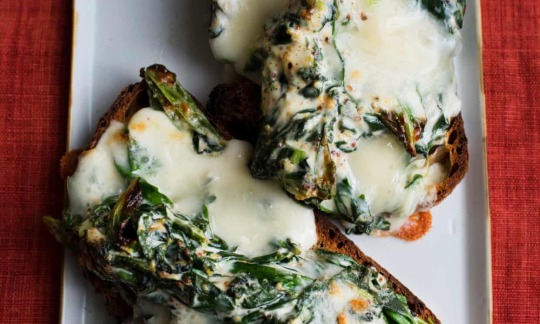
Taleggio melts particularly easily, but you could use fontina or any soft cheese should you wish. Wild garlic leaves have a short season, so I tend to make the most of them while they are here. I have yet to have any success with planting them in the garden.
Serves 2
spinach 250g, in the bunch crème fraîche 5 tbsp grain mustard 1 tsp garlic leaves 20g butter a thin slice sourdough bread 2 thick slices taleggio 70g parmesan 20g
Wash the spinach thoroughly and remove the toughest of the stalks. Without shaking the leaves dry, put them into a large saucepan over a moderate heat, covered tightly with a lid.
Let them steam for a minute or two, then turn the spinach over, and continue cooking until the leaves have wilted. Drain and refresh the leaves in iced water. Squeeze the leaves in the palm of your hand to remove as much water as possible, then separate them as best you can. If the leaves are very large, chop them roughly.
Mix together the crème fraîche and mustard in a mixing bowl. Put the spinach in the bowl then fold into the mustard crème fraîche and a little salt and black pepper. Toast the pieces of sourdough until lightly crisp and golden on both sides. Remove the stalks of the garlic leaves and cut them into small dice. Keep the leaves intact. Cook the leaves and chopped stems for a minute or two in the butter, just until the leaves wilt. Remove, drain and stir in the spinach.
Get the oven grill hot. Pile the spinach and garlic mixture on to the toasted bread. Tear the taleggio into large pieces and tuck among the spinach. Grate the parmesan and scatter over the top then grill until the cheese melts but remove from the heat before it turns gold.
Photograph: Jonathan Lovekin for the Observer
1 note
·
View note
Text
Thai green vegetable soup
Nigel Slater | The Guardian

Serves 2-4
white peppercorns 1 tsp coriander seeds 1 tsp turmeric 1 tsp lemon grass 2 stalks garlic 2 cloves ginger a 3cm lump, peeled hot green chillies 3 small groundnut oil fresh coriander a handful vegetable stock 200ml coconut milk 250ml fish sauce 1 tbsp lime juice 2 tbsp spring vegetables, such as asparagus tips, broad beans, peas 450g total weight shredded greens, such as spring cabbage a handful pinch of sugar and soy sauce to serve
For the paste, put the white peppercorns and coriander seeds in a dry non-stick frying pan and toast lightly for 2 or 3 minutes, then tip into the bowl of a food processor and add half a teaspoon of sea salt, the ground turmeric, lemon grass, peeled garlic cloves, ginger, green chillies, 3 tablespoons of groundnut oil and a handful of coriander stems and roots. Blitz to a course paste. You can keep this paste for a few days in the fridge, its surface covered with groundnut oil to prevent it drying out.
In a deep pan, fry 3 lightly heaped tablespoons of the curry paste in a tablespoon of oil for 30 seconds till fragrant, stirring as you go. Stir in the vegetable stock and coconut milk, the fish sauce and lime juice.
Add the asparagus tips, broad beans and peas and continue simmering for 5-6 minutes, then drop in a couple of handfuls of greens, shredded into thick ribbons. Finish the soup with a pinch of sugar, fish sauce, a little soy sauce, more lime.
Photograph: Jonathan Lovekin for Observer Food Monthly
0 notes
Text
Roast Chicken Pho
Nigel Slater | The Guardian

Serves 2, generously
dark soy sauce 1 tbsp honey 1 tbsp mirin 1 tbsp chicken thighs 4 chicken stock 800ml ginger 6 "coins" lime juice 1 tbsp star anise 3 whole shredded greens or chard a handful rice noodles 100g
Mix a tablespoon of dark soy, with a tablespoon each of honey and mirin. Pour into a small roasting tin, add the chicken thighs and turn them over in the mixture till lightly coated. Roast at 200C/gas mark 6 for about 25-30 minutes, occasionally turning the thighs over in the honey and mirin. They should be very dark and sticky.
In a pan, warm the stock, ginger, lime juice and the star anise. As it approaches the boil, add a small handful of shredded greens or chard, cooking them for a minute or two only.
Put the rice noodles in a heatproof bowl and pour over a kettle of freshly boiled water. Leave them to soak for a couple of minutes until they are soft and silky. Divide the noodles between two deep bowls, slice the chicken from its bones and add to the noodles together with the greens, then ladle over the stock.
Photograph: Jonathan Lovekin for Observer Food Monthly
0 notes
Text
Grapefruit, Avocado and Prosciutto Breakfast Salad
MyRecipes
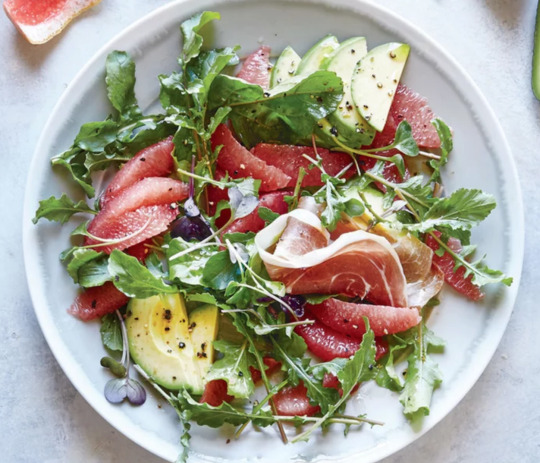
Bright, refreshing grapefruit pairs surprisingly well with nutty-earthy toasted sesame oil. This meal is full of satiating heart-healthy fats that will keep you full for a long time.
Serves 1
Ingredients
1 small ruby red grapefruit
3/4 teaspoon dark sesame oil
1/8 teaspoon freshly ground black pepper
Dash of kosher salt
1 cup microgreens, baby arugula, or torn lettuce
1/2 ripe peeled avocado, thinly sliced
1 very thin slice prosciutto
Method
Peel grapefruit; cut sections from grapefruit over a medium bowl. Squeeze membranes to extract about 1 tablespoon juice. Set sections aside. Add oil, pepper, and salt to juice, stirring with a whisk. Add greens; toss to coat. Arrange greens on a plate; top with grapefruit sections, avocado, and prosciutto.
Photo: Jennifer Causey
0 notes
Text
Grapefruit, Endive and Arugula Salad
CookingLight
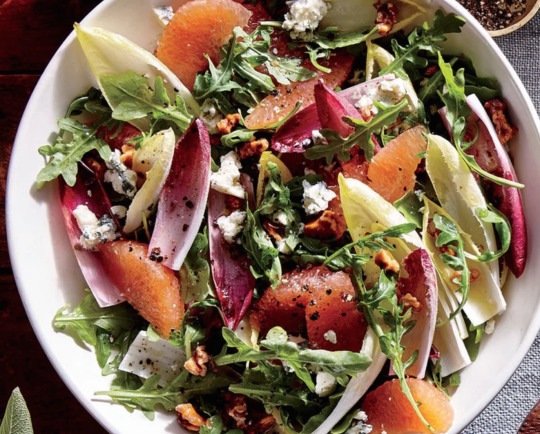
Tossing the endive leaves in the vinaigrette first softens their bitter edge. You could also sub thinly sliced fennel or chopped Romaine hearts.
Serves 8
Ingredients
2 medium red grapefruit
2 tablespoons fresh lemon juice
2 teaspoons honey
1 teaspoon Dijon mustard
1/4 teaspoon kosher salt
1/8 teaspoon freshly ground black pepper
1/4 cup olive oil
4 small heads endive, trimmed, leaves separated
1 (5-oz.) container baby arugula
1/4 cup chopped walnuts, toasted
2 ounces Gorgonzola cheese, crumbled (about 1/2 cup)
Method
Peel and section grapefruit over a bowl; squeeze membranes over a bowl to extract juice.
Combine lemon juice, honey, mustard, salt, pepper, and 3 tablespoons reserved grapefruit juice in a bowl, stirring with a whisk. Gradually add oil, stirring constantly with a whisk. Place 1/4 cup vinaigrette in a bowl; add endive. Let stand 10 minutes.
Arrange half of arugula on a serving platter, and top with endive mixture, remaining half of arugula, walnuts, cheese, and reserved grapefruit sections. Drizzle with remaining vinaigrette.
Photo: Jennifer Causey
0 notes
Text
Dip for Gyoza
sesame seeds 15g mirin 2 tbsp rice vinegar 2 tbsp caster sugar 1 tsp soy sauce 3 tsp sesame oil ½ tsp
Toast the sesame seeds for a couple of minutes in a dry, shallow pan. When deep gold in colour, tip them into a small bowl, add the mirin, rice vinegar, sugar, soy and sesame oil and stir until the sugar has dissolved.
Nigel Slater
2 notes
·
View notes
Text
Roast Chicken, Lime and Mint Salad
Nigel Slater | The Guardian

For a midweek salad I use thighs or drumsticks, so the chicken cooks quickly. It will of course work with a whole bird, too.
Serves 2
chicken drumsticks 4 large groundnut oil a little salt and pepper to season butter a thick slice cucumber 1, small mint leaves a handful watercress 2 handfuls radish sprouts a handful
For the dressing limes 2 fish sauce 1 tbsp
Set the oven at 200C/gas mark 6.
Put the chicken drumsticks in a small roasting tin, pour over the oil, season with salt and pepper and add the butter. Roast for 30 minutes or so, until they are golden and the skin is lightly crisp.
Remove the flesh from the bones, leaving in large, juicy but manageable pieces.
Squeeze the lime juice into the roasting tin and place over a medium heat. Add the fish sauce and warm gently, scraping at any sticky bits on the pan and stirring them into the dressing. Check for seasoning – it may need a little ground black pepper.
Slice the cucumber with a vegetable peeler, to give long, wide shavings. I do this by shaving the cucumber on all four sides then discarding the central core of seeds.
Return the chicken pieces to the pan and toss gently in the dressing. Tear the mint leaves into large pieces, then toss them with the cucumber and the watercress.
Assemble the salad by putting the watercress, cucumber and radish sprouts on to plates then spooning over the warm chicken and its dressing. Finish with a few more radish sprouts and mint if you wish.
Photograph: Jonathan Lovekin for the Observer
1 note
·
View note